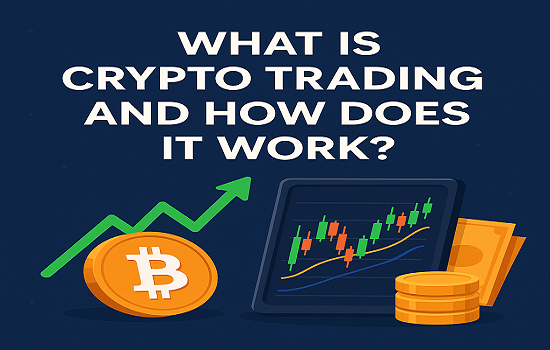Cryptocurrency is no longer a fringe technology—it’s a financial revolution. At the heart of this revolution is crypto trading, a fast-growing market that’s drawing in investors, institutions, and everyday traders worldwide.
If you’re asking, “What is crypto trading and how does it work?”, this guide is here to walk you through the basics—from how it operates to what you need to get started.
What Is Crypto Trading?
Crypto trading is the process of buying and selling cryptocurrencies—like Bitcoin, Ethereum, or Solana—with the goal of making a profit. It works much like trading stocks or forex, but with some unique twists:
- It operates 24/7 (unlike traditional markets).
- It’s based on decentralized digital assets.
- It’s influenced by market sentiment, news, and blockchain developments.
In simple terms, crypto trading is about speculating on the price movements of cryptocurrencies to earn returns.
How Does Crypto Trading Work?
Crypto trading works through exchanges, platforms where traders buy and sell digital assets. Here’s how the process works:
1. Choose a Crypto Exchange
First, traders need to create an account on a cryptocurrency exchange such as:
These platforms allow you to deposit funds (fiat or crypto), choose trading pairs (e.g., BTC/USDT), and execute trades.
2. Analyze the Market
Successful crypto traders use:
- Technical analysis (TA) – using charts and indicators to predict price movements.
- Fundamental analysis (FA) – evaluating the project’s utility, news, or team.
- Sentiment analysis – tracking social media and market psychology.
3. Choose a Trading Strategy
Here are some popular crypto trading strategies:
- Day Trading: Short-term trades within a single day.
- Swing Trading: Holding positions for days or weeks.
- Scalping: High-frequency trading for small profits.
- Holding: Long-term investing based on belief in asset growth.
4. Place the Trade
Once a trade is planned:
- Choose a buy or sell position.
- Set a market or limit order.
- Use risk management tools like stop-loss or take-profit levels.
5. Monitor & Manage
Markets are volatile, so constant monitoring or using trading bots can help reduce risk and increase efficiency.
Types of Crypto Trading
Understanding the different types of trading helps you find what suits your goals best.
| Type | Description |
|---|---|
| Spot Trading | Buying/selling assets instantly at current prices. |
| Margin Trading | Borrowing funds to amplify profits (and losses). |
| Futures Trading | Trading contracts that bet on future prices. |
| P2P Trading | Buying/selling directly with other users, often using fiat. |
| Automated Trading | Using bots or AI to execute trades based on set parameters. |
Why Do People Trade Cryptocurrency?
People are drawn to crypto trading for various reasons:
- High Volatility: Big price swings mean big opportunities.
- Accessibility: Anyone with internet access can participate.
- Decentralization: No central authority controlling your assets.
- Innovation: Exposure to Web3, NFTs, DeFi, and beyond.
However, it’s not without risks. Prices can be unpredictable, and losses can mount quickly—especially with leverage.
Tools and Tips for Crypto Trading Beginners
Want to start trading crypto? Here’s what you need:
- A reliable exchange
- A secure crypto wallet
- Access to real-time charts (like TradingView)
- A clear trading plan
- Strong risk management (never trade more than you can afford to lose)
Pro Tip: Start small, practice with demo accounts, and never chase the hype blindly.
Conclusion: Is Crypto Trading Right for You?
Crypto trading is an exciting way to participate in the future of finance. But it’s important to educate yourself, practice caution, and build strategies that match your risk tolerance and financial goals.
Whether you’re looking to day trade Bitcoin or invest long-term in Ethereum, understanding how cryptocurrency trading works is the first step toward making informed decisions.






































